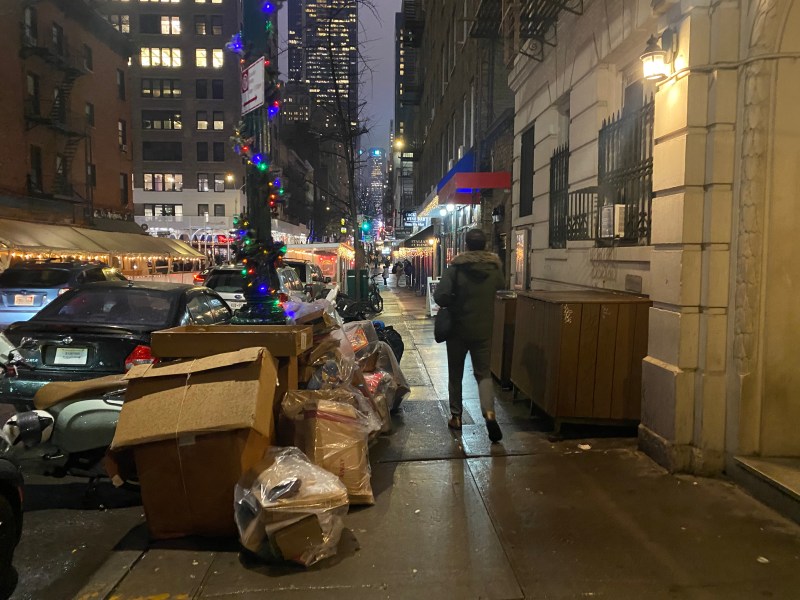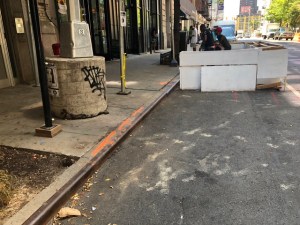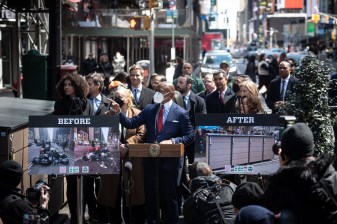Sanitation Restaurant Trash Plan Threatens to Gobble Up More Sidewalk: Advocates

New York City’s already crowded sidewalks could get even more clogged under a new proposal to let restaurants leave trash cans out at all hours — spurring some advocates to call on the city to have eateries put their waste receptacles in the street.
“If you don’t have space to store it, leave it in the parking space?” asked Christine Berthet, founder of the group CHEKPEDS and a transportation co-chair of Manhattan Community Board 4. The option of using street space currently devoted to cars for trash is “not ever discussed” at the city level, she added.
Many businesses don’t have enough storage space inside, so DSNY will allow them to keep the bins outside, albeit within three feet of buildings and out of the way of pedestrians, according to the proposed policy.
But pedestrians may nevertheless find themselves penned in on both sides as trash from other buildings awaits collection on one side of the sidewalk and the containers line the other side, Berthet said.
“We’ll now be surrounded not just on one side, but on two sides by garbage and containers,” she said. “This is irresponsible.”
The proposal is part of Mayor Adams’s ambitious and overdue push to shift the city’s waste collection from bags to containers, and get rid of the Big Apple’s notorious trash mountains. “Containerization” is possible on 89 percent of city streets with residential building, according to an in-depth report released last month by DSNY.
For higher density areas, the study recommended stationary shared bins in the street along the curb, which will require repurposing a historic number of street space the city currently allocates for car storage. A test-run this autumn will bring wheeled containers in the curb to up to 10 residential blocks and the 14 public schools in West Harlem.
A spokesman for the agency defended the policy, but welcomed the feedback.
“Large mounds of black bags are the problem, both in terms of attracting rats and in terms of stealing usable public space. Getting the trash into containers will make our pedestrian spaces cleaner and more passable,” said DSNY Deputy Commissioner Joshua Goodman.
“I feel strongly that requiring these businesses to place their trash in bins on the sidewalk will improve the pedestrian experience in the city. Under this proposal, they can only store the container within three feet of the building line, which is in line with current rules, for example about merchandise displays.”
Goodman declined to say why the city didn’t propose having restaurants put containers in the roadway, other than to note logistical challenges to expanding wheeled bins in the roadway citywide. Curbside trash bins would likely require the Department of Transportation to change parking regulations to keep the spaces clear for the bins — a big political lift in a city where even removing parking for loading space enrages car-owners.
“I think ultimately New Yorkers are going to have to make some hard decisions, do they want parking spaces or do they want their trash in a container so that we don’t have rats,” said Council Member Sandy Nurse (D-Brooklyn), who heads the Council’s Committee on Sanitation.
The pol said she supports containerization and “accessibility,” but declined to say whether she supported placing the bins in the road.

DSNY is currently testing street-based trash collection with its Clean Curbs pilot, which placed shared containers on commercial strips in all five boroughs and on one residential block in Hells Kitchen. Commissioner Jessica Tisch deemed the effort “not scalable” citywide because it drained resources and some bags still ended up outside the containers.
Bins on the street may not be the best option, said Clare Miflin, an architect and the founder of the Center for Zero Waste Design. Instead, the city should tie containerization of commercial waste into its long-stalled effort to create commercial waste zones, Miflin said.
“Take up the street before the pedestrian [space], but I’m just asking, do we need to take up the street?” she told Streetsblog.
Of the 44 million daily pounds of trash New York produces each day — the weight of about 140 statues of Liberty — more than half, or 51 percent, is commercial waste, which dozens of private carters collect.
The agency’s study focused mostly on residential waste, but also proposed incentivizing developers or large commercial buildings to carve out storage space for containers. It will be crucial that buildings that have the storage space actually use it, rather than put their bins outside for convenience, Miflin said.
“I don’t want empty cars or empty waste bins taking up the streets if it could just be rolled out and then back in the building at night,” she said.
The Department of Sanitation will hold a virtual hearing on the rule change on June 22 at 10 a.m. To tune use this link. You can also submit comments through the city’s rules website at http://rules.cityofnewyork.us, or via email at nycrules@dsny.nyc.gov.





